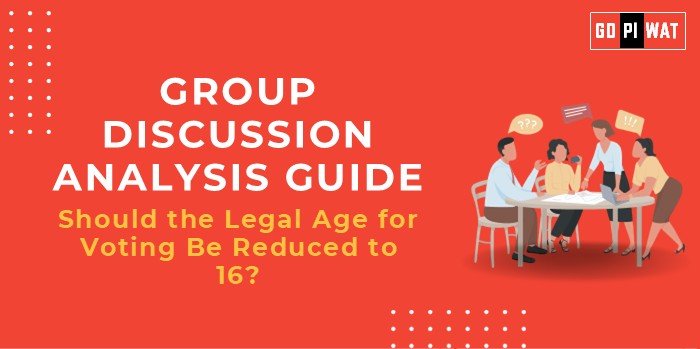📋 Group Discussion (GD) Analysis Guide: Should the Legal Age for Voting Be Reduced to 16?
🌐 Introduction to the Topic
- 💡 Opening Context: Debates around voting age are at the forefront of discussions about youth engagement in democracy. Globally, some countries like Austria and Brazil allow 16-year-olds to vote, highlighting the growing recognition of young voices in governance.
- 📜 Topic Background: The movement to lower the voting age aims to empower youth by integrating their perspectives into policy decisions. Proponents argue that increased civic participation could foster responsibility, while critics point to the maturity and political awareness needed to make informed choices.
📊 Quick Facts and Key Statistics
- 🌍 Countries with Voting Age 16: Austria, Malta, Scotland – Demonstrates global precedence.
- 👩👦 India’s Youth Population: 253 million aged 16-24 – A significant demographic with potential influence on elections.
- 📜 Legal Voting Age History: Lowered from 21 to 18 in 1989 – Indicates adaptability of laws to societal changes.
- 🗳️ Youth Voter Turnout (2021): 50%-60% globally – Highlights active participation in some regions.
👥 Stakeholders and Their Roles
- 🏛️ Government: Decision-making authority for constitutional amendments.
- 🎓 Youth Organizations: Advocacy for lowering the voting age.
- 📚 Education Institutions: Promoting civic literacy and awareness.
- ⚙️ Political Parties: Engaging young voters to gain electoral advantage.
- 👨👩👧👦 Society: Shaping perceptions of youth capability in governance.
🏆 Achievements and Challenges
✨ Achievements
- 🧠 Youth civic engagement: Fosters early awareness of national issues.
- 📜 Evidence from Austria: Shows 16-year-olds are as informed as older voters.
- 🤝 Representation: Can bolster youth-centric policies.
⚠️ Challenges
- 🤔 Concerns over maturity: Questions about emotional and political readiness of 16-year-olds.
- 👥 Influence risks: Vulnerability to family or peer opinions.
- 📖 Education gaps: Lack of civic education in many regions.
🌍 Global Comparisons
- 🇦🇹 Austria: High youth voter turnout after lowering the age to 16.
- 🏴 Scotland: Success in engaging 16- and 17-year-olds in referendums.
💬 Structured Arguments for Discussion
- 💪 Supporting Stance: “Lowering the voting age will empower youth and ensure policies reflect their priorities.”
- ⚖️ Opposing Stance: “Sixteen-year-olds lack the maturity and life experience to make informed voting decisions.”
- 🤝 Balanced Perspective: “While the move could enhance representation, implementing civic education and safeguarding against misuse is essential.”
📚 Effective Discussion Approaches
- 💡 Opening Approaches:
- 📊 “With 253 million young Indians, should their voices remain unheard until 18?”
- 🌍 “Globally, countries like Austria prove that youth can make informed decisions.”
- 🤔 Counter-Argument Handling:
- 🧠 “While maturity is a concern, studies show that 16-year-olds are no less informed than their older counterparts when provided with proper education.”
🔎 Strategic Analysis of Strengths and Weaknesses
- 💪 Strengths: Increased representation, youth empowerment, long-term voter engagement.
- 🛑 Weaknesses: Risk of political manipulation, insufficient education on civic duties.
- 🌟 Opportunities: Enhance education systems, set global precedent for youth inclusion.
- ⚠️ Threats: Political polarization, resistance from traditionalists.
🎓 Connecting with B-School Applications
- 📊 Real-World Applications:
- Policy analysis on youth engagement and governance.
- Potential marketing strategies targeting young demographics for campaigns.
- ❓ Sample Interview Questions:
- 🗳️ “What impact could reducing the voting age have on India’s democratic process?”
- 📖 “How can civic education be improved to support informed youth voting?”
- 📝 Insights for Students:
- 📋 Importance of understanding demographics in policy-making.
- 🔍 Analysis of youth-driven markets and campaigns.


